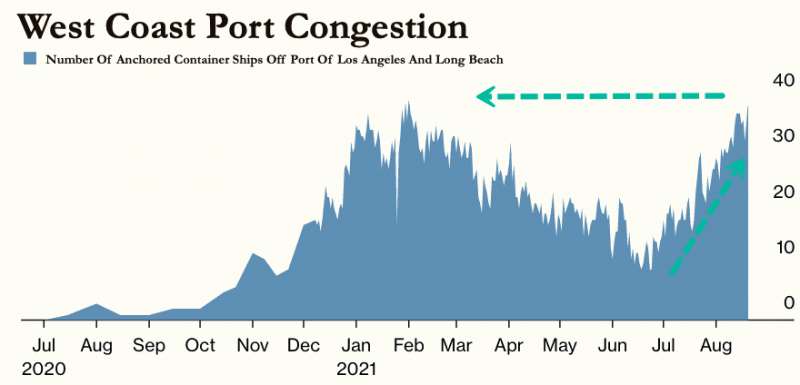
US West Coast Port Congestion At Record High Amid Transpacific Trade Route Disruptions
Peak shipping season is underway, and container ships anchored off California are on the verge of record congestion.
New data from Marine Exchange of Southern California & Vessel Traffic Service of Los Angeles and Long Beach ports shows port congestion outside the busiest US gateway for trade with Asia is rapidly building and rose to 40 vessels on Friday, tying the record high set on Feb. 1.
According to the Port of Los Angeles, the average wait time for a vessel increased to 7.1 days, up from 6.2 days a week ago.
Bloomberg notes, “the delays along key transpacific trade routes may be exacerbated by recent Covid outbreaks at Asian ports.”
Readers may recall the collapse of the trans-pacific supply chains has been among the main reasons for soaring consumer goods prices. It’s also hardly a secret that the most vulnerable section of supply chains are West Coast ports where congestion remains off the charts and could soon reach uncharted territory in the coming weeks.
The transpacific trade routes have experienced significant port delays in China in recent weeks because COVID outbreaks are shutting down terminals.
Goldman Sachs has explicitly warned that “port closures or stricter control measures at ports could also put further upward pressure on shipping costs, which are already very high.”
There is some good news in Asia, Chinese authorities are set to reopen the container terminal at the massive Port of Ningbo in the near term, as long as no COVID infections are detected.
The timing of this bottleneck at US West Coast ports comes at an inopportune time for US importers who are ordering back-to-school and restocking goods ahead of the upcoming holiday season. Persisting trans-pacific supply chains disruptions means consumers may experience price rises of certain products and or shortages.
Besides congestion in California, East Coast ports are also reporting increasing bottlenecks.


